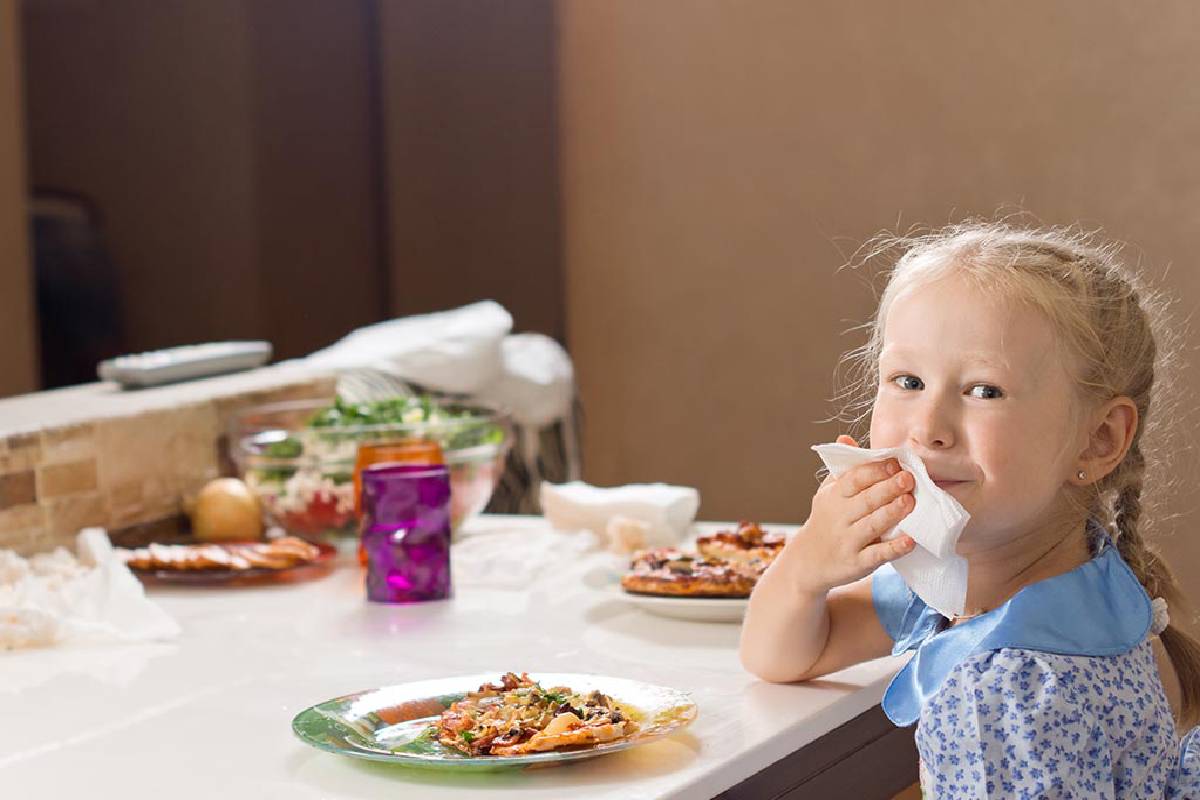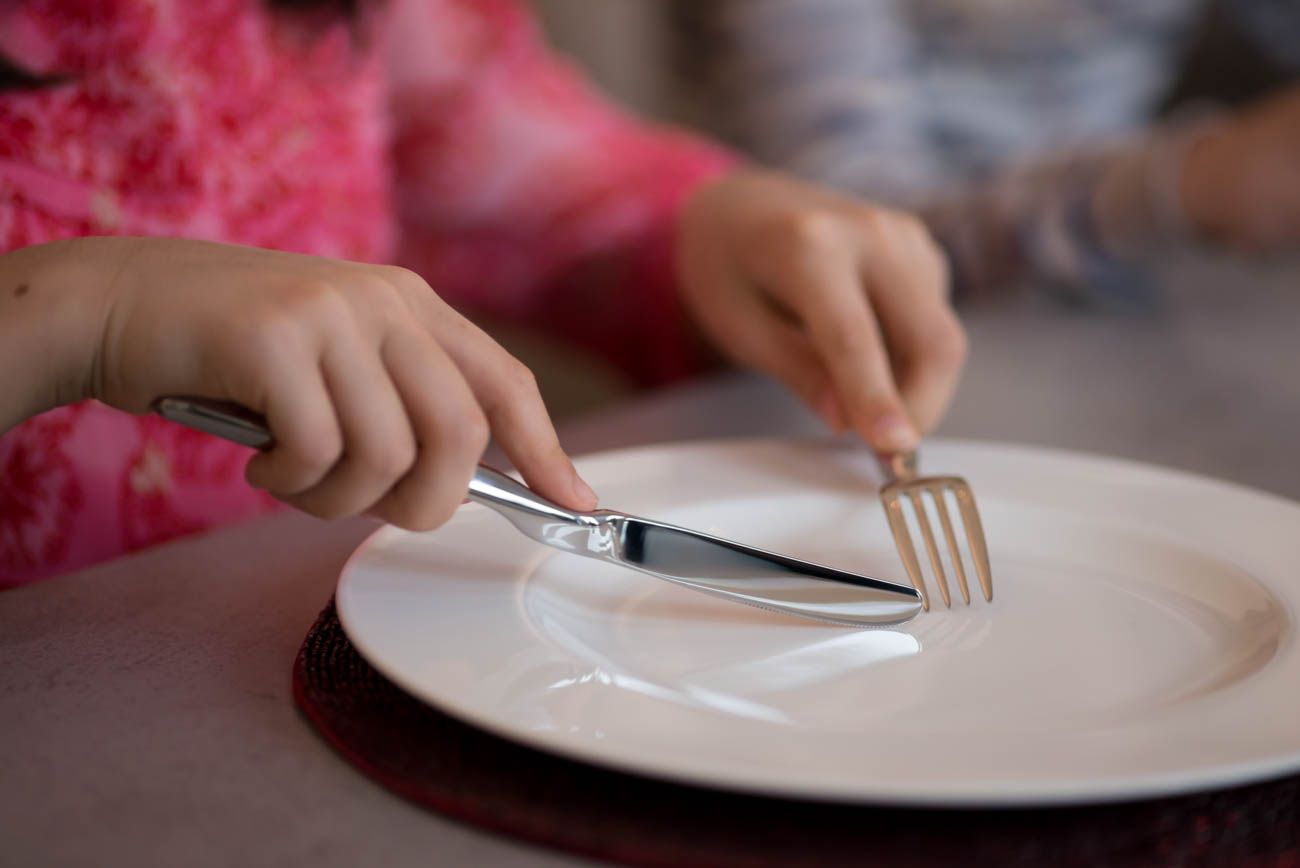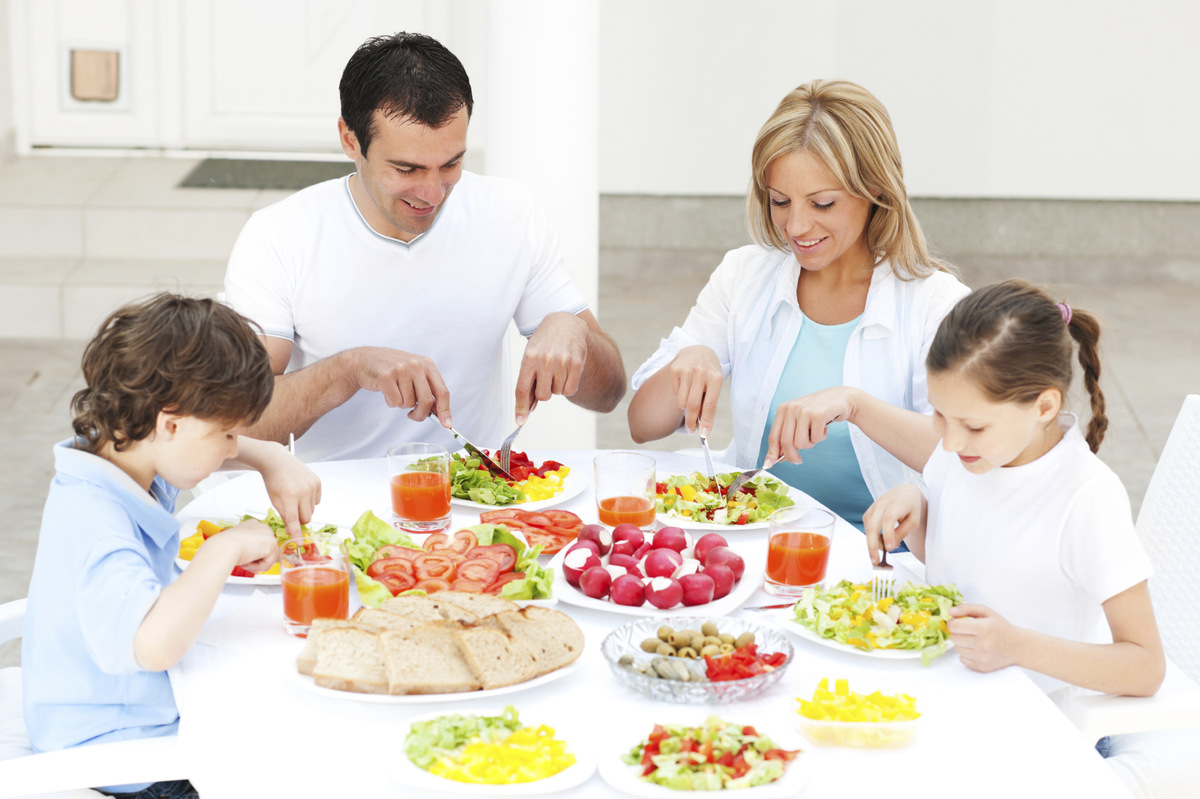Home>Dining>Events & Etiquette>Why Teach Table Manners To Kids


Events & Etiquette
Why Teach Table Manners To Kids
Modified: January 9, 2024
Teach your kids table manners with our comprehensive guide to events etiquette. Help them develop social skills and proper dining habits for a lifetime of success.
(Many of the links in this article redirect to a specific reviewed product. Your purchase of these products through affiliate links helps to generate commission for Storables.com, at no extra cost. Learn more)
Introduction
Table manners are an essential aspect of proper etiquette that plays a significant role in our daily lives. They are not just a set of arbitrary rules, but rather a way to show respect, consideration, and appreciation towards others. While teaching table manners to children may seem like a daunting task, it is a vital part of their overall development and socialization.
In today’s fast-paced world, it is important to instill good table manners in children from a young age. By teaching them the proper way to behave at the table, we are equipping them with skills that will benefit them throughout their lives.
This article explores the importance of teaching table manners to kids, the benefits it offers, effective ways to teach them, and tips for addressing common challenges. Whether you are a parent, a caregiver, or an educator, this article will provide you with valuable insights and practical strategies to cultivate good table manners in children.
Key Takeaways:
- Cultivating good table manners in children fosters respect, gratitude, and self-discipline, laying the foundation for positive social interactions and healthy eating habits throughout their lives.
- Teaching table manners to kids creates a nurturing and enjoyable dining atmosphere, encouraging responsibility, resilience, and a positive relationship with food and family members.
Read more: How To Teach A Child Table Manners
Importance of teaching table manners
Teaching table manners to kids is not just about upholding social decorum. It goes beyond ensuring they know which fork to use or how to hold a spoon properly. The importance of teaching table manners extends to various aspects of a child’s personal and social development.
Firstly, table manners help children build social skills. When kids learn how to conduct themselves at the table, they become more confident and comfortable in social situations. They gain the ability to interact and communicate effectively with others, whether it be at a family dinner, a school event, or a formal gathering. By practicing good table manners, children learn the importance of listening, taking turns, and showing respect to others, which are essential skills for building strong relationships throughout their lives.
Additionally, teaching table manners to kids promotes healthy eating habits. When children are aware of proper table etiquette, they are more likely to engage in mindful eating. They learn the importance of sitting down, focusing on their meals, and paying attention to hunger cues. By slowing down and savoring their food, children can develop a healthier relationship with food and are less likely to overeat or engage in unhealthy eating habits like mindless snacking.
Another important aspect of teaching table manners is the development of self-discipline and self-control. By learning to wait for their turn, to use utensils instead of their hands, and to chew with their mouth closed, children develop self-regulation skills. These skills can extend beyond the dinner table and help children navigate challenging situations, manage their impulses, and make thoughtful decisions in other areas of their lives.
Moreover, teaching table manners instills values such as respect and gratitude. By saying “please” and “thank you,” children learn to appreciate the effort put into preparing a meal and understand the importance of acknowledging the people who contribute to their well-being. They develop empathy, understanding that their actions and words have an impact on others. Showing respect and expressing gratitude become natural practices that carry over into all aspects of their lives.
Lastly, teaching table manners reduces mealtime stress for both children and adults. When children know what is expected of them at the table, it creates a more harmonious environment. By eliminating disruptive behaviors like talking with their mouth full or playing with their food, mealtime becomes enjoyable and relaxing. It allows families to bond, engage in meaningful conversations, and create lasting memories.
In summary, teaching table manners to kids is important because it helps them build social skills, promotes healthy eating habits, enhances self-discipline and self-control, teaches respect and gratitude, and reduces mealtime stress. By imparting these invaluable skills and values, we are equipping children with the tools they need to navigate social interactions and thrive in various aspects of their lives.
Benefits of teaching table manners to kids
Teaching table manners to kids goes beyond simply teaching them how to use utensils or sit properly at the table. It has a multitude of benefits that contribute to their overall development and well-being. Here are some of the key benefits:
- Building social skills: When children learn and practice good table manners, they develop essential social skills. They learn how to engage in polite conversation, take turns, listen actively, and show respect and consideration for others. These skills are transferable to various social settings and lay the foundation for positive relationships in their future.
- Promoting healthy eating habits: Teaching table manners helps children develop a positive relationship with food. By encouraging them to sit down at the table and focus on their meals, they become more mindful eaters. This can lead to healthier eating habits, including better portion control, reduced snacking, and an appreciation for nutritious foods.
- Enhancing self-discipline and self-control: Following proper table manners requires self-discipline and self-control. Children learn to wait for their turn, chew with their mouth closed, and use utensils instead of their hands. These practices promote self-regulation skills that can be applied in other aspects of their lives, such as managing emotions and controlling impulses.
- Teaching respect and gratitude: Table manners reinforce the importance of showing respect for others. Children learn to say “please” and “thank you,” expressing gratitude for the effort put into preparing the meal and acknowledging the people around them. These practices foster an attitude of respect and gratitude that extends beyond the dining table.
- Reducing mealtime stress: When children have a clear understanding of what is expected of them during mealtime, it creates a more pleasant and relaxed dining experience for everyone. By eliminating disruptive behaviors and distractions, mealtime becomes an opportunity for families to connect and bond, making it a less stressful and more enjoyable experience.
These benefits highlight the importance of teaching table manners to kids. It is not just about conforming to social norms, but about equipping children with valuable life skills that will serve them well in their personal and social interactions. By cultivating good table manners from early on, children are more likely to develop healthy habits, navigate social situations with ease, and establish strong relationships built on respect and consideration.
Building social skills
Teaching table manners to kids plays a significant role in building their social skills. Table manners provide a framework for appropriate behavior during mealtime, which extends beyond the dining table and into various social settings.
When children practice good table manners, they learn how to engage in polite conversation and actively listen to others. This skill is invaluable in developing strong communication skills, as it teaches children the importance of taking turns and respecting others’ viewpoints. They learn to ask questions, respond appropriately, and contribute to the conversation in a respectful manner.
Table manners also teach children the importance of showing respect and consideration for others. When they learn to wait for their turn to speak or to pass the serving utensils, they understand the concept of taking turns and valuing the needs and preferences of others. This helps them develop empathy and understanding, which are essential qualities for building positive and meaningful relationships.
By practicing good table manners, children are also exposed to different social norms and cultural practices. They learn to adapt to different dining situations and understand the importance of respecting and appreciating diversity. This exposure to different customs and traditions helps children become more open-minded and inclusive individuals.
Additionally, table manners provide children with an opportunity to practice self-control and self-regulation. When they learn to sit still, use utensils properly, and chew with their mouth closed, they develop self-discipline. These skills extend beyond the dining table and help them navigate challenging situations, manage their impulses, and make thoughtful decisions in other social contexts.
Practicing table manners also helps children build confidence and self-esteem. When they are praised for exhibiting good table manners, it reinforces their sense of accomplishment and encourages further positive behavior. This positive reinforcement boosts their self-confidence and encourages them to actively engage in social situations.
Overall, teaching table manners to kids is an effective way to build their social skills. It provides them with the tools and understanding of appropriate behavior in various social settings. By cultivating good table manners from a young age, children develop the ability to communicate effectively, show respect and consideration for others, adapt to different cultural practices, practice self-control, and build confidence. These social skills lay the foundation for positive relationships and set them on a path towards success in their personal and professional lives.
Promoting healthy eating habits
Teaching children table manners is not only about etiquette; it also plays a significant role in promoting healthy eating habits. By instilling good table manners, we can help children develop a positive relationship with food and encourage them to make healthier choices.
One of the key aspects of promoting healthy eating habits through table manners is the concept of mindful eating. Mindful eating is the practice of paying attention to our food, eating slowly, and savoring each bite. By teaching children to sit down at the table, eliminate distractions, and focus on their meals, they become more aware of their hunger and satiety cues. This awareness can prevent overeating and encourage them to eat until they feel satisfied, rather than consuming food mindlessly.
Proper table manners also encourage children to try a variety of foods. When children are taught to wait patiently and be open to different dishes, they are more likely to explore new flavors and textures. This exposure to a wide range of foods helps expand their palate and encourages a diverse and nutritious diet.
Table manners can also help manage portion control. When children learn to serve themselves appropriate portions and use utensils instead of eating with their hands, it promotes mindful eating and prevents overeating. By practicing portion control at the table, children develop a better understanding of how much food they actually need, which can help prevent obesity and other health issues in the long run.
Furthermore, table manners can discourage unhealthy snacking habits. When children are taught to wait until mealtime and not munch on snacks throughout the day, it promotes hunger awareness and encourages them to consume balanced meals. By reducing mindless snacking, children are more likely to make nutritious food choices during mealtimes and maintain a healthier overall diet.
Teaching table manners also includes teaching proper eating etiquette, such as not talking with their mouth full or not slurping or smacking their lips. This not only promotes hygienic eating practices but also helps children become more aware of their eating habits. By developing these basic etiquette skills, children can carry them into their adult lives, ensuring they continue to practice mindful eating and maintain healthy habits.
Overall, teaching table manners to children promotes healthy eating habits by encouraging mindful eating, promoting exploration of new foods, managing portion control, discouraging unhealthy snacking, and developing eating etiquette. By incorporating these habits into their daily routines, children establish a foundation for a lifetime of healthy eating and maintain a positive relationship with food.
Read more: Why Table Manners Are Important
Enhancing self-discipline and self-control
Teaching table manners to kids goes beyond polite behavior; it also plays a crucial role in enhancing their self-discipline and self-control. By following proper table etiquette, children develop a sense of self-regulation that extends beyond mealtime.
One aspect of self-discipline that is fostered through table manners is learning to wait for their turn. When children practice patience at the table by waiting for their serving or for others to finish speaking, it teaches them delayed gratification. This skill becomes valuable in various aspects of their lives, helping them control impulsive behaviors, manage their emotions, and make thoughtful decisions.
Proper table manners also teach children to use utensils instead of their hands. By instructing them to hold utensils correctly, cut their food into appropriate sizes, and chew with their mouth closed, it encourages self-control. They learn to resist the urge to grab food with their hands and instead use the appropriate tools, showcasing their ability to self-regulate their actions.
Another aspect of self-discipline enhanced through table manners is learning to sit still and maintain composure. By teaching children to remain seated and engaged during mealtime, it helps them develop focus and concentration. This skill can transfer to other areas of their lives, such as during schoolwork or extracurricular activities, where they need to maintain attention and concentration.
Table manners also reinforce the importance of following rules and expectations. By setting clear guidelines for behavior at the table, children learn to adhere to these rules. This instills a sense of responsibility and self-discipline as they understand the importance of respecting the established norms and standards.
Additionally, practicing good table manners involves controlling one’s impulses. Children are taught not to reach across the table, grab food from others’ plates, or finish their meals hastily. By learning to control these impulses, children develop self-discipline and the ability to resist immediate gratification. This discipline can translate into other areas of their lives, such as managing their spending or studying for exams.
Overall, teaching table manners helps enhance children’s self-discipline and self-control. By learning to wait their turn, use utensils, sit still, follow rules, and control impulses, children develop invaluable skills that extend beyond the dining table. These skills empower them to make thoughtful decisions, manage their emotions, and exhibit self-control in different aspects of their lives, contributing to their overall personal growth and development.
Teaching respect and gratitude
Teaching table manners to kids is not just about proper etiquette; it also provides an opportunity to instill values of respect and gratitude. By incorporating these values into mealtime routines, children learn to appreciate the effort put into meal preparation and develop a greater understanding of the importance of showing respect towards others.
One way table manners teach respect is through the use of polite language. Teaching children to say “please” and “thank you” when requesting or receiving food encourages respectful communication. By using these words, children learn to acknowledge and appreciate the efforts of those who contribute to their meal. This practice fosters a sense of gratitude and respect for the people around them.
In addition, teaching table manners emphasizes treating others with consideration and respect. Children learn to wait for their turn, share serving utensils, and pass dishes to others before helping themselves. By practicing these actions, they understand the importance of considering the needs and preferences of others and showing respect for their dining companions.
Furthermore, proper table manners teach children to listen actively and attentively. By encouraging children to listen to others during mealtime conversations, they develop respect for others’ perspectives and opinions. This practice fosters empathy and understanding, which are essential qualities for building positive relationships and promoting a harmonious dining experience.
Table manners also provide an opportunity for children to express gratitude. By using polite language and showing appreciation for the meal and those who prepared it, they learn the value of expressing gratitude. This practice extends beyond the dining table, teaching children to acknowledge and appreciate the efforts of others in various aspects of their lives.
Teaching respect and gratitude through table manners also helps children develop a sense of responsibility. By setting clear expectations and guidelines for behavior at the table, children learn to take responsibility for their actions. They understand that their behavior not only affects themselves but also the experience and well-being of those around them. This awareness promotes a sense of respect for the dining environment and for others’ enjoyment of the meal.
Overall, teaching table manners provides an opportunity to teach children important values of respect and gratitude. By incorporating polite language, encouraging consideration for others, practicing active listening, and expressing appreciation, children learn to behave respectfully and develop a greater understanding of the importance of showing gratitude. These values extend beyond the dining table and contribute to the development of empathetic and respectful individuals.
Reducing mealtime stress
Mealtime can sometimes become a stressful and chaotic experience, especially with children. However, teaching table manners to kids can help reduce mealtime stress and create a more enjoyable and relaxed atmosphere for the whole family.
One way table manners contribute to reducing stress is by setting clear expectations. When children are taught and consistently reminded of the expected behavior at the table, they understand the boundaries and know what is considered appropriate. By establishing these guidelines, parents and caregivers can minimize conflicts and disagreements during mealtime, creating a more peaceful and harmonious environment.
Additionally, good table manners discourage disruptive behaviors. When children are taught to avoid behaviors such as talking with their mouth full, playing with their food, or interrupting others, it helps maintain a calm and pleasant ambiance at the table. Eliminating these disruptive behaviors reduces stress and allows everyone to focus on enjoying the meal and engaging in meaningful conversations.
Practicing good table manners also encourages active listening. When children are taught to listen attentively and patiently, it promotes respectful and meaningful communication during mealtime. By actively listening, children feel heard and understood, which promotes a positive and relaxed atmosphere at the table.
Moreover, teaching table manners includes establishing a routine and structure around mealtime. Setting regular meal times and creating a predictable routine can help alleviate stress. When children have a clear expectation of when and where meals will take place, it reduces anxiety and creates a sense of stability and comfort.
Incorporating a sense of fun and enjoyment into mealtime can also help reduce stress. By making mealtime a pleasant and engaging experience, children are more likely to participate willingly and less likely to exhibit disruptive behaviors. Parents and caregivers can incorporate games, conversation starters, or sharing daily highlights to create a lighthearted and enjoyable atmosphere during meals.
Finally, teaching table manners provides an opportunity to connect as a family. By emphasizing the importance of gathering together and sharing a meal, it creates a space for bonding and strengthening familial relationships. Taking the time to engage in meaningful conversations, share stories, and express appreciation for each other fosters a sense of connection and reduces stress by nurturing positive family dynamics.
In summary, teaching table manners to kids helps reduce mealtime stress by establishing clear expectations, discouraging disruptive behaviors, promoting active listening, creating a routine, incorporating fun and enjoyment, and fostering family connections. By incorporating these strategies, mealtime can become a more relaxing and enjoyable experience for everyone involved.
Effective ways to teach table manners to kids
Teaching table manners to kids can be a transformative experience that sets them up for a lifetime of socially graceful and respectful dining. Here are some effective strategies to instill good table manners in children:
- Lead by example: Children learn best by observing and imitating. Model good table manners yourself and demonstrate how to sit properly, use utensils correctly, and engage in polite conversation. Your actions speak louder than words, so make sure to exhibit the behaviors you want your children to emulate.
- Set clear expectations: Communicate your expectations about table manners explicitly. Be consistent and make sure your children understand the rules and consequences of not following them. Use positive reinforcement and praise children when they exhibit good table manners.
- Make mealtime enjoyable: Create a positive and inviting atmosphere at the table. Play soft background music, engage in interesting conversation, and encourage everyone to share their experiences or thoughts. Making mealtime enjoyable helps children associate good table manners with pleasant experiences.
- Practice and reinforce good habits: Regularly practice table manners during meals. Encourage children to use utensils correctly, chew with their mouths closed, and take turns speaking. Provide gentle reminders when needed and praise their efforts. Consistency and reinforcement are key to developing lasting habits.
- Start early: Introduce table manners as soon as children begin eating solid foods. Starting early allows children to develop good habits from the beginning and gives them a solid foundation to build upon as they grow.
- Use visual aids: Utilize visual aids such as placemats or posters that illustrate proper table manners. These visual reminders can help children remember the expectations and serve as a point of reference during mealtime.
- Role-play and practice: Engage children in role-playing scenarios where they can pretend to be guests at a formal dinner or a restaurant. This helps them understand different dining situations and practice appropriate etiquette. You can also have mock “fancy” meals at home to reinforce proper table manners.
- Encourage self-awareness: Teach children to be mindful of their actions and the impact they have on others. Ask them questions like, “How do you think it feels when someone interrupts you while speaking?” This encourages empathy and helps children understand the importance of respectful and considerate behavior.
- Offer gentle reminders: During mealtime, provide gentle reminders about specific table manners, such as using a napkin instead of a shirt sleeve or not speaking with a full mouth. Use gentle and constructive language to reinforce the importance of these behaviors without shaming or embarrassing the child.
- Patience and repetition: Teaching table manners is an ongoing process that requires patience and repetition. Understand that children will need reminders and practice to fully grasp and internalize proper etiquette. Be consistent, patient, and supportive throughout the learning process.
By employing these effective strategies, you can guide your children to develop and maintain good table manners that will serve them well in social situations throughout their lives. Remember to make the learning experience enjoyable and foster a positive and respectful atmosphere at the table.
Tip: Start teaching table manners to kids at a young age by setting a good example, using positive reinforcement, and making mealtime a positive and enjoyable experience.
Lead by example
One of the most effective ways to teach table manners to kids is to lead by example. Children are highly influenced by the behavior they observe, especially from their parents, caregivers, and other significant adults in their lives. When children see adults practicing good table manners, they are more likely to emulate those behaviors themselves.
Leading by example involves consistently modeling the desired table manners during meals. Here are some key ways to lead by example when teaching table manners:
Use utensils properly: Show your children the proper way to hold and use utensils, starting from a young age. Use the correct cutlery for each food and demonstrate how to cut, scoop, and eat in a calm and controlled manner. Explain the importance of using utensils instead of fingers and encourage your children to do the same.
Eat with your mouth closed: Practice chewing with your mouth closed and demonstrate to your children how to do so. Emphasize the importance of not talking while chewing to avoid food particles from falling out of the mouth. Encourage children to take smaller bites and chew thoroughly before speaking.
Practice patience and take turns: Show patience and model taking turns during mealtime conversations. Encourage active listening and wait for others to finish speaking before responding. Demonstrate respectful and inclusive conversational skills by asking questions, making eye contact, and showing genuine interest in what others have to say.
Show respect for others’ food preferences: Be mindful of others’ dietary needs and preferences. Avoid making negative comments about food choices and demonstrate respect for different food cultures and traditions. Encourage your children to have an open mind and try new foods, while also accepting their preferences without judgment.
Use polite language: Model using polite language and saying “please” and “thank you” during mealtime interactions. Demonstrate gratitude for the efforts of the person who prepared the meal, and encourage your children to express their appreciation as well. Polite language fosters an environment of respect and gratitude.
Practice good table hygiene: Demonstrate proper table hygiene by using a napkin instead of wiping hands on clothing, sneezing or coughing into a tissue or elbow, and avoiding touching your face while eating. Encourage your children to follow these practices to maintain cleanliness and respect for the dining environment.
Be patient and understanding: Understand that teaching table manners takes time and that children are bound to make mistakes. Be patient and use constructive feedback when addressing improper behaviors. Emphasize that learning proper table manners is a process and encourage your children to continue practicing and improving.
Remember, children are highly observant and learn by imitation. When they see you consistently exhibiting good table manners, they are more likely to adopt those behaviors themselves. Leading by example not only teaches children proper table manners but also instills values of respect, gratitude, and consideration for others. By being a positive role model, you can guide your children towards becoming polite, socially adept, and well-mannered individuals.
Set clear expectations
When teaching table manners to kids, it is essential to set clear expectations regarding their behavior at the table. By establishing these expectations, children understand the standards and guidelines they are expected to follow during mealtime. Here are some key strategies for setting clear expectations:
Communicate the rules: Clearly communicate the rules and expectations for table manners to your children. Explain what behaviors are acceptable and what behaviors are not. Use simple and age-appropriate language to ensure understanding. For example, you can explain that it is important to sit up straight, use utensils, and chew with their mouth closed.
Be consistent: Consistency is crucial when setting expectations for table manners. Ensure that the rules are consistently enforced and applied by all family members. When children experience consistency, they are more likely to understand the importance of adhering to the expectations and will develop a sense of routine and stability during mealtime.
Explain the reasons: Provide explanations for why certain table manners are expected. Help children understand the rationale behind each rule so that they can see the value in following them. For example, explain that using utensils keeps hands clean and prevents the spread of germs.
Use visual aids: Utilize visual aids such as placemats, charts, or posters that outline the expected table manners. These visual cues serve as reminders for children and help reinforce the consistent application of the rules. They can include images or simple instructions that depict proper behaviors, making it easier for children to internalize and remember them.
Reinforce positive behavior: When children exhibit good table manners, acknowledge and praise their efforts. Reinforce positive behavior by providing verbal encouragement, giving a thumbs-up, or offering small rewards. Positive reinforcement helps motivate children to continue practicing and maintaining good table manners.
Specify consequences: Clearly outline the consequences for not following the established table manners. Consequences should be appropriate and age-specific, such as gentle reminders, loss of privileges, or a brief time-out from the table. Clearly communicating consequences helps children understand the importance of adhering to the expectations.
Encourage self-monitoring: Teach children to be self-aware and responsible for their own behavior. Encourage them to self-evaluate their table manners and make adjustments when needed. This self-monitoring instills a sense of accountability and empowers children to take ownership of their actions.
Revisit and reinforce: Regularly review and reinforce the table manners expectations with your children. It is natural for children to need reminders and reinforcement as they develop and refine their skills. By consistently revisiting the expectations, you can ensure that they are internalizing the rules and practicing good table manners consistently.
Lead by example: Set the example by following the table manners yourself. Children are more likely to emulate behaviors they see demonstrated by adults. When they observe you consistently practicing good table manners, it reinforces their understanding of the expectations and motivates them to follow suit.
Setting clear expectations for table manners provides children with a framework for appropriate behavior during mealtime. By implementing these strategies, you create a structured and consistent environment that allows children to develop and maintain good table manners. Ultimately, this will promote a positive and respectful dining experience for the entire family.
Make mealtime enjoyable
Mealtime should be a time of connection, nourishment, and enjoyment. When teaching table manners to kids, it is important to create a positive and pleasant atmosphere during meals. By making mealtime enjoyable, you can foster a love for gathering around the table and instill a sense of appreciation for the dining experience. Here are some effective strategies to make mealtime enjoyable:
Create a welcoming environment: Set the mood by creating a welcoming and comfortable dining space. Use soft lighting, play relaxing background music, and arrange the table in an inviting manner. Consider involving children in setting the table, which can make them feel engaged and excited about the meal.
Engage in conversation: Encourage conversation during mealtime by asking open-ended questions or sharing interesting stories. This creates a relaxed and interactive atmosphere where everyone can participate and contribute. Encourage children to express their thoughts, ask questions, and actively listen to others. By engaging in meaningful conversations, mealtime becomes an opportunity for connection and family bonding.
Introduce games and activities: Make mealtime fun by incorporating games or activities that are suitable for the dining table. Try word games, trivia quizzes, or sharing interesting facts related to the meal. These activities not only entertain children but also promote engagement and learning in a playful manner.
Vary the menu: Introduce a variety of foods to make mealtime exciting. Experiment with different flavors, cuisines, and textures. Involve children in the meal planning process, such as selecting a new recipe or choosing fresh ingredients from the grocery store. By allowing them to be part of the decision-making, they become more invested in the meal and are more likely to enjoy it.
Celebrate cultural traditions: Incorporate cultural traditions into mealtime to celebrate diversity and heritage. Explore different customs, holidays, or traditional dishes from various cultures, and discuss their significance. This helps children develop an appreciation for different cultures and broadens their culinary horizons.
Practice gratitude: Encourage family members to express gratitude for the meal and each other. Take a moment before or after the meal to share what you are grateful for. This fosters an atmosphere of appreciation and positivity, promoting a sense of well-being and contentment during mealtime.
Encourage creativity: Allow children to express their creativity during mealtime. Consider allowing them to help with simple food preparations, such as arranging fruits in a fun design or creating a colorful salad. Encourage them to explore new flavors and textures by arranging food in an appealing manner on their plates. Incorporating creativity can make mealtime more enjoyable and engaging for children.
Share responsibilities: Involve children in age-appropriate tasks related to the meal, such as setting the table, serving dishes, or cleaning up. Sharing responsibilities not only lightens the load for caregivers but also gives children a sense of accomplishment and contribution. This fosters a cooperative and supportive environment during mealtimes.
Connect with nature: Whenever possible, have meals outdoors or near a window to enjoy natural surroundings. Connecting with nature during mealtime can be incredibly refreshing and soothing. It allows children to appreciate the beauty of the environment and can spark conversations about the importance of the natural world.
By implementing these strategies, you can create a joyful, engaging, and relaxing atmosphere during mealtime. Making mealtime enjoyable not only facilitates the teaching of table manners but also cultivates a positive relationship with food, fosters family connections, and promotes overall well-being. Mealtime becomes a cherished experience filled with love, laughter, and shared memories.
Practice and reinforce good habits
Teaching table manners to kids requires consistent practice and reinforcement to help them develop and maintain good habits. By establishing a routine and providing ongoing support, you can effectively instill proper table manners. Here are some strategies to practice and reinforce good habits:
Consistent practice: Make regular family meals a priority to provide ample opportunities for practicing table manners. Encourage children to participate in meal preparation, setting the table, and serving food. Engage them in age-appropriate tasks that contribute to the overall dining experience.
Repetition and reinforcement: Continuously reinforce the importance of good table manners. Remind children of the expectations before each meal and reinforce positive behaviors when they exhibit proper table manners. Celebrate their efforts and provide specific feedback on their progress.
Break it down: Break down proper table manners into smaller, manageable steps for young children. Teach them one new skill at a time and gradually build upon their knowledge. For example, start with holding a fork correctly, then progress to using a napkin, and eventually incorporate more complex skills like engaging in conversation.
Provide gentle reminders: Offer gentle reminders during mealtime to guide children’s behavior. Use positive and constructive language to remind them to sit up straight, chew with their mouth closed, or use utensils properly. Avoid shaming or criticizing; instead, offer gentle prompts that can help redirect their attention.
Use visual cues: Utilize visual cues to reinforce good habits. Post visual reminders, such as placemats or charts depicting proper table manners, at the dining table. This serves as a reference point to remind children of the behaviors expected of them and helps reinforce consistent application of good habits.
Encourage self-monitoring: Teach children to monitor their own behavior and self-correct when necessary. Encourage them to be aware of their posture, utensil usage, and conversation etiquette. By fostering self-monitoring skills, children can take ownership of their actions and become more self-reliant in practicing good table manners.
Offer positive role models: Expose children to positive role models who exhibit good table manners. Encourage them to observe and learn from adults or older siblings who consistently demonstrate proper behaviors. This allows children to see firsthand how table manners should be practiced.
Practice in different settings: Help children generalize their table manners by practicing in different settings. Whether it be at home, in a restaurant, or at a social gathering, expose children to a variety of dining environments. This helps them adapt and apply their good habits in different situations.
Celebrate progress: Acknowledge and celebrate the progress your child makes in developing good table manners. Offer praise and rewards for their efforts and achievements. Celebrating milestones and positive behavior helps motivate children and reinforces the importance of practicing and maintaining proper table manners.
Lead by example: Model good table manners yourself and reinforce the notion that table manners are important for everyone. Consistently exhibit proper behavior, engage in respectful conversation, and practice all the good habits you are teaching your child. Children are more likely to emulate behaviors they witness regularly.
By incorporating these strategies into your routine, you can effectively practice and reinforce good table manners. Remember, creating a positive and supportive environment is essential in helping children develop and maintain these habits. Through consistent practice, gentle reminders, positive reinforcement, and leading by example, you can help your child become a confident and respectful diner.
Addressing common challenges
Teaching table manners to kids can come with its fair share of challenges. However, with the right strategies and patience, these challenges can be effectively addressed. Here are some common challenges that may arise during the process of teaching table manners and how to handle them:
Dealing with picky eaters: If your child is a picky eater, it can be challenging to teach table manners since they may be resistant to trying new foods. Encourage them to have at least a bite of each dish, and gradually introduce new foods in small portions. Keep the focus on fostering a positive and respectful attitude towards food, rather than forcing them to eat. Provide a variety of options and allow them to make choices within reasonable limits.
Handling fidgeting and impatience: Some children may find it difficult to sit still and remain patient during mealtime. Engage them in conversation or provide quiet activities like coloring or puzzles to keep them occupied. Set age-appropriate time limits for mealtime to help children understand the expected duration. Encourage them to practice self-control by reminding them of the importance of sitting and participating in mealtime with respect and attention.
Managing food spills and accidents: Young children are prone to spills and accidents at the table. Be prepared for such incidents by having napkins, towels, or wipes readily available. Rather than expressing frustration or anger, calmly guide your child in cleaning up the spill and encourage them to learn from the experience. Reinforce the importance of being careful and mindful while handling food and utensils.
Encouraging participation in conversation: Some children may be shy or reluctant to participate in mealtime conversations. Create a supportive environment by asking open-ended questions and giving them time to respond. Encourage them to share their thoughts or experiences by actively listening and showing genuine interest. Avoid pressuring them and provide positive reinforcement when they contribute to the conversation.
Limiting distractions: Minimize distractions during mealtime, such as television or electronic devices. Establish a “no screens at the table” rule to encourage engagement and focus on the meal and each other. Create an atmosphere where mealtime is seen as a time for connection and meaningful conversation.
Handling disagreements: Disagreements can arise at any family meal. Teach children respectful ways to express their opinions and listen to others’ perspectives. If conflicts occur, model effective conflict resolution strategies by remaining calm, encouraging active listening, and finding common ground. Emphasize the importance of respectful communication and remind children to use polite language even during disagreements.
Addressing negative behavior: If a child consistently displays negative behavior at the table, it is important to address it promptly and firmly. Set clear boundaries and consequences for inappropriate behavior, such as leaving the table or loss of privileges. Instead of focusing solely on punishment, actively teach and reinforce the desired behaviors to redirect their actions towards positive ones.
Being patient and consistent: Teaching table manners takes time and consistency. Be patient and understanding when children make mistakes or struggle with certain aspects of table manners. Reinforce positive behaviors and provide gentle reminders as needed. Consistency is key in helping children internalize good habits and develop a positive attitude towards mealtime.
By addressing these common challenges with patience, understanding, and consistent guidance, you can overcome obstacles and create a positive and enjoyable dining experience. Remember to focus on building a respectful and healthy relationship with food, nurturing good habits, and fostering a positive atmosphere during mealtime.
Dealing with picky eaters
Handling picky eaters can be a common challenge when teaching table manners. Picky eaters often have strong food preferences and may be resistant to trying new foods. However, with patience and a strategic approach, you can help picky eaters develop a more diverse palate and a positive attitude towards food. Here are some strategies for dealing with picky eaters:
Lead by example: Show your child that you are open to trying new foods and have a positive attitude towards different flavors and textures. Let them observe you enjoying a variety of dishes, and use positive language to describe the taste and appeal of different foods.
Introduce new foods gradually: Rather than overwhelming your picky eater with a plate full of unfamiliar foods, introduce new foods gradually. Start with small portions or incorporate new ingredients alongside familiar ones, allowing your child to become more comfortable with different flavors and textures over time.
Involve your child in meal planning and preparation: Let your child take part in meal planning and preparation. Take them grocery shopping and let them choose a new fruit, vegetable, or ingredient to try. This involvement gives them a sense of ownership and may make them more willing to try new foods.
Create a positive food environment: Make mealtimes pleasant and stress-free. Create a positive and relaxed atmosphere where your child feels comfortable trying new foods without pressure. Avoid negative comments or punishment related to food choices as it can create anxiety and reinforce picky eating habits.
Offer a variety of options: Provide a range of food options, including familiar favorites and new foods. Encourage your child to try a small portion of new foods without forcing or pressuring them. Respect their preferences but gently encourage them to explore their palate by incorporating a variety of colors, flavors, and textures on their plate.
Be creative with food presentation: Make food visually appealing by presenting it in fun and creative ways. Use cookie cutters to shape fruits and vegetables, arrange food into colorful patterns, or make faces with different food items. Making meals visually appealing can pique a child’s interest and make trying new foods more exciting.
Offer positive reinforcement: Praise and reward your child’s efforts in trying new foods or exhibiting positive eating behaviors. Focus on the process rather than the outcome. Offer verbal encouragement, stickers, or small rewards to reinforce their progress and build confidence in exploring new foods.
Respect your child’s preferences: While it is important to encourage your child to try new foods, respect their preferences and avoid forced feeding. The goal is to expand their food choices gradually, not to completely change their preferences overnight. Respecting their choices creates a positive environment and encourages autonomy in decision-making.
Make meals enjoyable: Engage your child in conversation and make mealtimes enjoyable. Talk about their favorite foods, share interesting facts about different ingredients, or play simple games that involve discussion. A positive and engaging atmosphere can help distract from any anxiety surrounding new foods and make trying them a more enjoyable experience.
Patience is key: Remember that picky eating habits don’t change overnight. Every child is different, and it may take time for them to warm up to new foods. Be patient, understanding, and consistent in your approach. Continue to expose your child to different foods and encourage them to gradually expand their food choices.
By adopting these strategies, you can gradually encourage your picky eater to become more open to trying new foods. Focus on fostering a positive attitude towards food and providing an environment that encourages exploration and enjoyment. With time and patience, your child can develop a healthier and more varied diet while learning good table manners along the way.
Handling fidgeting and impatience
Dealing with fidgeting and impatience during mealtime can be challenging, but with patience and a proactive approach, you can help your child develop better self-control and improve their table manners. Here are some strategies for handling fidgeting and impatience during mealtime:
Set clear expectations: Clearly communicate the expectations for behavior during mealtime. Let your child know that sitting still and patiently waiting are important. Explain why it is important to show respect for the meal and for others at the table.
Establish a routine: Create a consistent mealtime routine that includes designated start and end times. Having a predictable routine can help provide structure and reduce impatience. Communicate the schedule to your child so they know what to expect and can better manage their behavior.
Engage in conversation: To help distract from fidgeting and impatience, engage your child in conversation. Keep the conversation light and interesting to maintain their focus. Ask open-ended questions or share interesting stories to involve them in meaningful conversation that keeps them engaged during the meal.
Provide designated activities: Offer your child quiet activities to keep their hands and minds occupied during mealtime. Provide age-appropriate items such as coloring books, small puzzles, or quiet toys that can be used at the table. These activities can help redirect their fidgeting and provide a positive outlet for their energy.
Encourage mindful eating: Teach your child the importance of mindful eating. Encourage them to take their time, savor each bite, and pay attention to the flavors and textures of the food. By focusing on their meal, they are less likely to fidget or feel impatient.
Model good behavior: Model good behavior by demonstrating patience and attentiveness at the table. Show your child by example how to sit still, engage in conversation, and wait for others to finish before speaking. When they see you practicing good table manners, they are more likely to follow suit.
Establish positive reinforcement: Use positive reinforcement to encourage good behavior during mealtime. Praise your child when they exhibit patience and good table manners. Offer verbal encouragement, a high-five, or a small reward to acknowledge their efforts and motivate them to continue practicing good behavior.
Set realistic expectations: Be realistic with your expectations, especially for younger children. Understand that they may have shorter attention spans and more difficulty sitting still for extended periods. Gradually increase their ability to sit still as they grow older and become more accustomed to the routine of mealtime.
Take breaks if needed: If fidgeting and impatience become overwhelming, consider incorporating short breaks during the meal. Allow your child to briefly leave the table and engage in a physical activity, such as stretching or taking a quick walk. Use this time to reset their energy and refocus their attention before returning to the table.
Be patient and consistent: Remember that changes in behavior take time. Stay patient and consistent in your approach. Address fidgeting and impatience calmly and gently redirect your child’s focus to proper table manners. With practice and reinforcement, they will gradually improve their self-control and develop better mealtime behavior.
By employing these strategies, you can help your child manage fidgeting and impatience during mealtime. Patience, consistency, and positive reinforcement are key to gradually improving their behavior and instilling good table manners. With time, your child will become more comfortable and able to engage in mealtime without excessive fidgeting or impatience.
Managing food spills and accidents
Food spills and accidents are inevitable, especially when teaching table manners to young children. However, with a calm and proactive approach, you can effectively manage these mishaps and help your child develop a sense of responsibility and good dining etiquette. Here are some strategies for managing food spills and accidents during mealtime:
Be prepared: Have cleaning supplies readily available to quickly address spills and accidents. Keep a stack of napkins, paper towels, or wet wipes nearby so you can quickly clean up any messes. For larger spills, have a cloth or towel ready to soak up the liquid.
Stay calm: Reacting calmly and positively to food spills and accidents sets a supportive tone for your child. Avoid getting upset or showing frustration. Instead, reassure your child that accidents happen and emphasize the importance of learning from mistakes.
Encourage responsibility: Involve your child in the clean-up process to teach them responsibility. Depending on their age and ability, ask them to help wipe the spills or pick up any food that has fallen on the floor. Encourage them to take an active role in resolving the accident, which fosters accountability and good manners.
Teach proper handling of utensils: Help your child understand how to handle utensils properly to minimize spills. Offer guidance on how to scoop food onto their utensils, lift them without excessive tilting, and carry them safely to their mouth. Practice these skills during mealtime and reinforce proper techniques.
Model good behavior: Show your child how to respond to spills and accidents by modeling good behavior yourself. Remain calm and composed, and demonstrate the appropriate steps to clean up the mess. Let your child observe how you handle the situation with grace and good manners.
Encourage self-correction: Foster independent problem-solving skills by encouraging your child to identify and rectify their own spills or accidents. Offer gentle guidance and ask them questions like, “What can you do to clean that up?” This approach helps them take ownership of their actions and develop problem-solving skills.
Provide positive reinforcement: Praise your child for their efforts in managing spills and accidents. Focus on their responsible behavior and how they handle the situation. Positive reinforcement helps boost their confidence and encourages them to continue practicing good table manners.
Use accidents as learning opportunities: Use spills and accidents as teaching moments. Discuss with your child how they can prevent similar incidents in the future, such as being more aware of their movements, using utensils more carefully, or asking for help when needed. This reflection reinforces the importance of good table manners and can help prevent future accidents.
Practice preventive measures: Preempt spills by using spill-proof cups or placing a mat or tablecloth underneath your child’s place setting. Avoid overfilling plates or cups to minimize the likelihood of accidental spills. These preventive measures can minimize the frequency of accidents and help create a more relaxed dining experience.
Have a sense of humor: Maintaining a sense of humor can help diffuse tension and make spills and accidents less stressful. Laughing together about mishaps creates a positive atmosphere and helps your child feel more comfortable and less anxious about making mistakes.
Remember that spills and accidents are a normal part of the learning process. By managing them calmly, teaching responsibility, and maintaining a positive attitude, you can help your child develop good table manners and the ability to handle spills and accidents with grace and resilience.
Conclusion
Teaching table manners to kids is an important aspect of their overall development and socialization. It goes beyond simply learning the rules of etiquette; it instills values of respect, gratitude, self-discipline, and consideration for others. By cultivating good table manners in children from a young age, we are setting them up for success in social interactions and creating a positive dining experience for the whole family.
Throughout this article, we have explored the significance of teaching table manners and the multitude of benefits it offers. We discussed how table manners build social skills, promote healthy eating habits, enhance self-discipline and self-control, teach respect and gratitude, and reduce mealtime stress. These benefits are crucial for children’s personal and social development, as they learn to engage in polite conversation, make mindful food choices, exhibit self-control, and show appreciation for others.
To effectively teach table manners to kids, we discussed various strategies, such as leading by example, setting clear expectations, making mealtime enjoyable, practicing and reinforcing good habits, and addressing common challenges. By incorporating these strategies into daily routines, we can guide children to develop and maintain proper table manners in a positive and supportive environment.
Whether dealing with picky eaters, fidgeting, spills, or impatience, we provided approaches to overcome these challenges with patience, understanding, and consistency. The goal is to create a nurturing and enjoyable dining atmosphere that encourages children to learn and practice good table manners while building positive relationships with food and family members.
In conclusion, teaching table manners to kids is an investment in their future. By imparting the knowledge, skills, and values associated with proper etiquette, we equip them with invaluable tools for success in various social settings throughout their lives. As we lead by example, set clear expectations, make mealtime enjoyable, and address challenges with patience and understanding, we create an environment that fosters respect, gratitude, self-control, and healthy eating habits.
So let us embrace the opportunity to teach table manners to our children, for it is not just about following societal norms—it is about fostering a culture of civility, connection, and appreciation that will shape them into respectful individuals who navigate social interactions with grace and charm.
Frequently Asked Questions about Why Teach Table Manners To Kids
Was this page helpful?
At Storables.com, we guarantee accurate and reliable information. Our content, validated by Expert Board Contributors, is crafted following stringent Editorial Policies. We're committed to providing you with well-researched, expert-backed insights for all your informational needs.












0 thoughts on “Why Teach Table Manners To Kids”